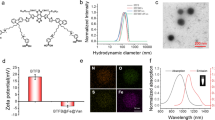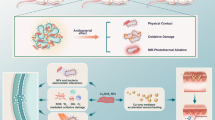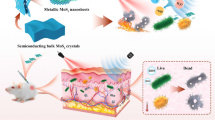Abstract
Antibiotic resistance is an increasingly serious threat to global public health, which can lead to the decrease of the effectiveness of antibiotics. The combination therapy of antibiotic and mild temperature photothermal therapy (PTT) is adopted to address this issue in this work. An antibiotic-loaded nanoplatform is fabricated based on two-dimensional (2D) molybdenum disulfide (MoS2) nanoflakes as effective near-infrared (NIR) photothermal agent. The MoS2 nanoflakes is modified with positively charged quaternized chitosan (QCS) to improve the dispersion stability and enhance the interaction between MoS2 nanoflakes and bacterial membrane. The QCS modified MoS2 nanoflakes (QCS-MoS2) is expected to adhere onto the membrane of methicillin-resistant Staphylococcus aureus (MRSA) and depolarize the bacterial membrane by local hyperthermia under NIR irradiation. A first-line antibiotic, ofloxacin (OFLX), can be loaded onto QCS-MoS2 by π-π stacking and hydrophobic interaction. Due to the combined antibiotic-photothermal therapy, superior bactericidal ability was achieved at mild temperature (45 °C) and low antibiotic concentration. Such synergistic mild-temperature photothermal/antibiotic therapy can not only avoid the damage to neighboring tissue by PTT, but also reduce the development of drug resistance, providing an innovative way for the treatment of bacterial infections.

Similar content being viewed by others
References
Levy, S. B.; Marshall, B. Antibacterial resistance worldwide: Causes, challenges and responses. Nat. Med.2004, 10, S122–S129.
Taubes, G. The bacteria fight back. Science2008, 321, 356–361.
Li, B. Y.; Webster, T. J. Bacteria antibiotic resistance: New challenges and opportunities for implant-associated orthopedic infections. J. Orthop. Res.2018, 36, 22–32.
Alanis, A. J. Resistance to antibiotics: Are we in the post-antibiotic era? Arch. Med. Res.2005, 36, 697–705.
Yang, X. L.; Zhang, L. M.; Jiang, X. Y. Aminosaccharide-gold nanoparticle assemblies as narrow-spectrum antibiotics against methicillin-resistant Staphylococcus aureus. Nano Res.2018, 11, 6237–6243.
Roy, I.; Shetty, D.; Hota, R.; Baek, K.; Kim, J.; Kim, C.; Kappert, S.; Kim, K. A Multifunctional subphthalocyanine nanosphere for targeting, labeling, and killing of antibiotic-resistant bacteria. Angew. Chem., Int. Ed.2015, 54, 15152–15155.
Hu, D. F.; Deng, Y. Y.; Jia, F.; Jin, Q.; Ji, J. Surface charge switchable supramolecular nanocarriers for nitric oxide synergistic photodynamic eradication of biofilms. ACS Nano2020, 14, 347–359.
Hu, X. N.; Zhao, Y. Y.; Hu, Z. J.; Saran, A.; Hou, S.; Wen, T.; Liu, W. Q.; Ji, Y. L.; Jiang, X. Y.; Wu, X. C. Gold nanorods core/AgPt alloy nanodots shell: A novel potent antibacterial nanostructure. Nano Res.2013, 6, 822–835.
Hu, D. F.; Li, H.; Wang, B. L.; Ye, Z.; Lei, W. X.; Jia, F.; Jin, Q.; Ren, K. F.; Ji, J. Surface-adaptive gold nanoparticles with effective adherence and enhanced photothermal ablation of methicillin-resistant Staphylococcus aureus biofilm. ACS Nano2017, 11, 9330–9339.
Yu, Q.; Chen, H. Smart antibacterial surfaces with switchable function to kill and release bacteria. Acta Polym. Sin.2020, 51, 319–325.
Wei, T.; Tang, Z. C.; Yu, Q.; Chen, H. Smart antibacterial surfaces with switchable bacteria-killing and bacteria-releasing capabilities. ACS Appl. Mater. Interfaces2017, 9, 37511–37523.
Li, J.; Liu, X. M.; Tan, L.; Cui, Z. D.; Yang, X. J.; Liang, Y. Q.; Li, Z. Y.; Zhu, S. L.; Zheng, Y. F.; Yeung, K. W. K. et al. Zinc-doped Prussian blue enhances photothermal clearance of Staphylococcus aureus and promotes tissue repair in infected wounds. Nat. Commun.2019, 10, 4490.
Gao, Y. F.; Wang, J.; Hu, D. F.; Deng, Y. Y.; Chen, T. T.; Jin, Q.; Ji, J. Bacteria-targeted supramolecular photosensitizer delivery vehicles for photodynamic ablation against biofilms. Macromol. Rapid Commun.2019, 40, 1800763.
Mao, C. Y.; Xiang, Y. M.; Liu, X. M.; Cui, Z. D.; Yang, X. J.; Li, Z. Y.; Zhu, S. L.; Zheng, Y. F.; Yeung, K. W. K.; Wu, S. L. Repeatable photodynamic therapy with triggered signaling pathways of fibroblast cell proliferation and differentiation to promote bacteria-accompanied wound healing. ACS Nano2018, 12, 1747–1759.
Yin, W. Y.; Yu, J.; Lv, F. T.; Yan, L.; Zheng, L. R.; Gu, Z. J.; Zhao, Y. L. Functionalized nano-MoS2 with peroxidase catalytic and near-infrared photothermal activities for safe and synergetic wound antibacterial applications. ACS Nano2016, 10, 11000–11011.
Korupalli, C.; Huang, C. C.; Lin, W. C.; Pan, W. Y.; Lin, P. Y.; Wan, W. L.; Li, M. J.; Chang, Y.; Sung, H. W. Acidity-triggered charge-convertible nanoparticles that can cause bacterium-specific aggregation in situ to enhance photothermal ablation of focal infection. Biomaterials2017, 116, 1–9.
Fan, X. L.; Li, H. Y.; Ye, W. Y.; Zhao, M. Q.; Huang, D. N.; Fang, Y.; Zhou, B. Q.; Ren, K. F.; Ji, J.; Fu, G. S. Magainin-modified polydopamine nanoparticles for photothermal killing of bacteria at low temperature. Colloids Surf. B.2019, 183, 110423.
Qu, Y. C.; Wei, T.; Zhao, J.; Jiang, S. B.; Yang, P.; Yu, Q.; Chen, H. Regenerable smart antibacterial surfaces: Full removal of killed bacteria via a sequential degradable layer. J. Mater. Chem. B2018, 6, 3946–3955.
Chen, J. Q.; Ning, C. Y.; Zhou, Z. N.; Yu, P.; Zhu, Y.; Tan, G. X.; Mao, C. B. Nanomaterials as photothermal therapeutic agents. Prog. Mater. Sci.2019, 99, 1–26
Gao, Q.; Zhang, X.; Yin, W. Y.; Ma, D. Q.; Xie, C. J.; Zheng, L. R.; Dong, X. H.; Mei, L. Q.; Yu, J.; Wang, C. Z. et al. Functionalized MoS2 nanovehicle with near-infrared laser-mediated nitric oxide release and photothermal activities for advanced bacteria-infected wound therapy. Small2018, 14, 1802290.
Hu, D. F.; Zou, L. Y.; Li, B. C.; Hu, M.; Ye, W. Y.; Ji, J. Photothermal killing of methicillin-resistant Staphylococcus aureus by bacteria-targeted polydopamine nanoparticles with nano-localized hyperpyrexia. ACS Biomater. Sci. Eng.2019, 5, 5169–5179.
Sun, P. P.; Zhang, Y.; Ran, X.; Liu, C. Y.; Wang, Z. Z.; Ren, J. S.; Qu, X. G. Phytochemical-encapsulated nanoplatform for “on-demand” synergistic treatment of multidrug-resistant bacteria. Nano Res.2018, 11, 3762–3770.
He, D. F.; Yang, T.; Qian, W.; Qi, C.; Mao, L.; Yu, X. Z.; Zhu, H. F.; Luo, G. X.; Deng, J. Combined photothermal and antibiotic therapy for bacterial infection via acidity-sensitive nanocarriers with enhanced antimicrobial performance. Appl. Mater. Today2018, 12, 415–429.
Tan, L.; Li, J.; Liu, X. M.; Cui, Z. D.; Yang, X. J.; Zhu, S. L.; Li, Z. Y.; Yuan, X. B.; Zheng, Y. F.; Yeung, K. W. K. et al. Rapid biofilm eradication on bone implants using red phosphorus and near-infrared light. Adv. Mater.2018, 30, 1801808.
Wei, T.; Yu, Q.; Chen, H. Responsive and synergistic antibacterial coatings: Fighting against bacteria in a smart and effective way. Adv. Healthcare Mater.2019, 8, 1801381.
Chen, M.; Chen, S. Z.; He, C. Y.; Mo, S. G.; Wang, X. Y.; Liu, G.; Zheng, N. F. Safety profile of two-dimensional Pd nanosheets for photothermal therapy and photoacoustic imaging. Nano Res.2017, 10, 1234–1248.
Zong, L. Y.; Wu, H. X.; Lin, H.; Chen, Y. A polyoxometalate-functionalized two-dimensional titanium carbide composite MXene for effective cancer theranostics. Nano Res.2018, 11, 4149–4168.
Bolotsky, A.; Butler, D.; Dong, C. Y.; Gerace, K.; Glavin, N. R.; Muratore, C.; Robinson, J. A.; Ebrahimi, A. Two-dimensional materials in biosensing and healthcare: From in vitro diagnostics to optogenetics and beyond. ACS Nano2019, 13, 9781–9810.
Tan, C. L.; Zhang, H. Two-dimensional transition metal dichalcogenide nanosheet-based composites. Chem. Soc. Rev.2015, 44, 2713–2731.
Liu, T.; Shi, S. X.; Liang, C.; Shen, S. D.; Cheng, L.; Wang, C.; Song, X. J.; Goel, S.; Barnhart, T. E.; Cai, W. B. et al. Iron oxide decorated MoS2 nanosheets with double PEGylation for chelator-free radiolabeling and multimodal imaging guided photothermal therapy. ACS Nano2015, 9, 950–960.
Feng, Z. Z.; Liu, X. M.; Tan, L.; Cui, Z. D.; Yang, X. J.; Li, Z. Y.; Zheng, Y. F.; Yeung, K. W. K.; Wu, S. L. Electrophoretic deposited stable chitosan@MoS2 coating with rapid in situ bacteria-killing ability under dual-light irradiation. Small2018, 14, 1704347.
Yin, W. Y.; Yan, L.; Yu, J.; Tian, G.; Zhou, L. J.; Zheng, X. P.; Zhang, X.; Yong, Y.; Li, J.; Gu, Z. J. et al. High-throughput synthesis of single-layer MoS2 nanosheets as a near-infrared photothermal-triggered drug delivery for effective cancer therapy. ACS Nano2014, 8, 6922–6933.
Yadav, V.; Roy, S.; Singh, P.; Khan, Z.; Jaiswal, A. 2D MoS2-based nanomaterials for therapeutic, bioimaging, and biosensing applications. Small2019, 15, 1803706.
Zhu, X. B.; Ji, X. Y.; Kong, N.; Chen, Y. H.; Mahmoudi, M.; Xu, X. D.; Ding, L.; Tao, W.; Cai, T.; Li, Y. J. et al. Intracellular mechanistic understanding of 2D MoS2 nanosheets for anti-exocytosis-enhanced synergistic cancer therapy. ACS Nano2018, 12, 2922–2938.
Nicolosi, V.; Chhowalla, M.; Kanatzidis, M. G.; Strano, M. S.; Coleman, J. N. Liquid exfoliation of layered materials. Science2013, 340, 1226419.
Chai, M. Y.; Gao, Y. F.; Liu, J.; Deng, Y. Y.; Hu, D. F.; Jin, Q.; Ji, J. Polymyxin B-polysaccharide polyion nanocomplex with improved biocompatibility and unaffected antibacterial activity for acute lung infection management. Adv. Healthcare Mater.2020, 9, 1901542.
Yao, Q. Q.; Ye, Z.; Sun, L.; Jin, Y. Y.; Xu, Q. W.; Yang, M.; Wang, Y.; Zhou, Y. L.; Ji, J.; Chen, H. et al. Bacterial infection microenvironment-responsive enzymatically degradable multilayer films for multifunctional antibacterial properties. J. Mater. Chem. B2017, 5, 8532–8541.
Liu, T.; Wang, C.; Gu, X.; Gong, H.; Cheng, L.; Shi, X. Z.; Feng, L. Z.; Sun, B. Q.; Liu, Z. Drug delivery with PEGylated MoS2 nano-sheets for combined photothermal and chemotherapy of cancer. Adv. Mater.2014, 26, 3433–3440.
Cho, J.; Grant, J.; Piquette-Miller, M.; Allen, C. Synthesis and physicochemical and dynamic mechanical properties of a water-soluble chitosan derivative as a biomaterial. Biomacromolecules2006, 7, 2845–2855.
Wang, J.; Zhuo, L. G.; Liao, W.; Yang, X.; Tang, Z. H.; Chen, Y.; Luo, S. Z.; Zhou, Z. J. Assessing the biocidal activity and investigating the mechanism of oligo-p-phenylene-ethynylenes. ACS Appl. Mater. Interfaces2017, 9, 7964–7971.
Zou, X. F.; Zhang, L.; Wang, Z. J.; Luo, Y. Mechanisms of the antimicrobial activities of graphene materials. J. Am. Chem. Soc.2016, 138, 2064–2077.
Yang, X.; Li, J.; Liang, T.; Ma, C. Y.; Zhang, Y. Y.; Chen, H. Z.; Hanagata, N.; Su, H. X.; Xu, M. S. Antibacterial activity of two-dimensional MoS2 sheets. Nanoscale2014, 6, 10126–10133.
Acknowledgements
Financial support from the National Natural Science Foundation of China (No. 21774110) and Fundamental Research Funds for the Central Universities (Nos. 2019QNA4063 and 2019XZZX005-1-03) is gratefully acknowledged.
Author information
Authors and Affiliations
Corresponding author
Electronic Supplementary Material
12274_2020_2853_MOESM1_ESM.pdf
Ofloxacin loaded MoS2 nanoflakes for synergistic mild-temperature photothermal/antibiotic therapy with reduced drug resistance of bacteria
Rights and permissions
About this article
Cite this article
Huang, Y., Gao, Q., Li, X. et al. Ofloxacin loaded MoS2 nanoflakes for synergistic mild-temperature photothermal/antibiotic therapy with reduced drug resistance of bacteria. Nano Res. 13, 2340–2350 (2020). https://doi.org/10.1007/s12274-020-2853-2
Received:
Revised:
Accepted:
Published:
Issue Date:
DOI: https://doi.org/10.1007/s12274-020-2853-2




